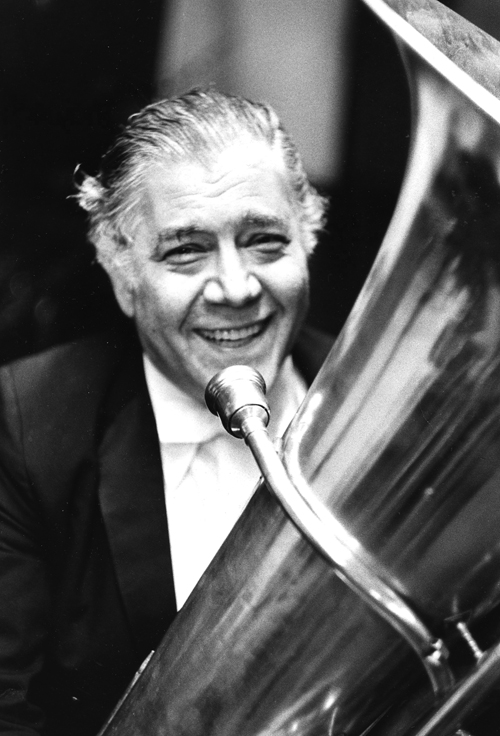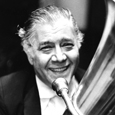
The first time I met Arnold Jacobs was after a concert the Chicago Symphony gave in Quincy, Illinois in the mid-1970s. Jacobs had been the soloist in the Vaughan Williams Bass Tuba Concerto. This performance was one of the first by a tuba soloist that I had ever heard. Obviously his performance was memorable for me since I can recall it so many years later. His tuba sound sang through the melodic lines, his intonation was impeccable, and his accuracy was perfection.
Jacobs, a graduate of the Curtis Institute of Music, played in the Chicago Symphony from 1944-1988. Besides his unparalleled career as a performer, he was remarkable teacher. Jacobs served on the faculty of the Bienen School of Music, Northwestern University for many years and each summer between 1980-1998 presented a weeklong masterclass on breathing for wind players and singers. Many of my colleagues and students benefitted from this class.
In the late 1980s I was practicing with my son who was a beginning horn student. During a practice session, several questions arose that I was not sure that I had the correct answer to, so I called Jacobs explaining that I was a flutist and not a brass player. Ordinarily I would not have called him out of the blue, but Jacobs had championed my husband’s brass music, so I felt he might be willing to talk with me. He was extremely cordial and certainly helpful.
Before I had a chance to ask my questions, Jacobs mentioned how similar the tuba and the flute were in air usage. He explained that both instruments required the highest air flow of all the wind instruments. He talked about the two types of basic breathing techniques that we employ in playing wind instruments, all the while making sure that I understood his concepts at every step of the way.
He remarked that many brass players develop problems in their playing because they rely too much on the embouchure to do the work and not the air stream. He felt a moving air stream was the key to expressive and pain-free playing. Jacobs remarked that many brass players (both student and professional) found their way to his studio to learn this concept.
Jacobs continued the conversation sharing his teaching philosophy. He said that after a tubist had played for him and he had assessed the situation, he fixed the most obvious problem before going on to the next.
For musical issues, he instructed his students to “play like a child,” meaning that they should play exactly what they saw on the page. Too often players chip the front of a note, put swells on long notes, do not play clean intervals, change the articulation, or do not follow the dynamics. Playing exactly what you see is accurate playing.
At this point, he asked, “And, what were your questions” to which I replied, “I believe you have answered them.” What a teacher! Obviously, my call was not the first of this type that he had received.
Air Flow
As Jacobs pointed out, both the tuba and the flute require a high flow of air to make a good sound. For beginning students, playing with fast air may make them feel light-headed or dizzy until they become accustomed to the constant blowing. Playing with fast air may also be tiring for some, whether they are a novice or experienced performer. However, Jacobs was correct. Fast air directed at the correct angle improves most players’ sound.
Take the headjoint holding it at each end with the thumb and index fingers. Keep the area in front of the embouchure hole clear so the air is free to move from the blowing edge in an unrestricted manner. Keeping the embouchure hole level, bring the headjoint into the chin. When instructing flutists, I am careful to say in the chin rather than on the chin. Placing the headjoint on the chin may result in the headjoint being too low for optimum results. Play a series of dotted half-notes followed by a quarter rest, f, while keeping the needle or dial still on a tuner. At this point do not worry about whether the note is flat or sharp. The goal is to expel an even stream of air. As you become proficient, work on playing the note in tune with even air.
If the tone is airy or without core, keeping the embouchure hole level and your head balanced on the spine, angle the air stream toward your left toes. Notice how you use your upper lip, lower lip and/or tongue to do this. When executing this exercise, I think of blowing so intensely that my air is putting the silver of the headjoint tube into vibration.
Abdomen: In and Out
When Jacobs asked me if I knew about the two types of breathing techniques, he was referring to the motion of the abdomen. To experience these two types lie on the floor on your back. Breathe normally for a few seconds to become aware of your breathing cycle. For the first type of breathing, inhale letting the abdomen rise toward the ceiling. As you exhale, pull the abdomen in. This is the type of breathing we use most often when playing. Then after a few breaths, explore the second type of breathing. On the inhale tighten the abdomen pulling abdomen toward the floor. On the exhale push the abdomen toward the ceiling. In playing good performers use both type one and two. Experiment to see whether a passage sounds better with each one. I find that type two works best for me on passages where I need to let the air out very slowly for a long period of time. I also use this type of breathing when I am moving a grand piano all by myself.
On Teaching
Jacobs is certainly correct when he suggests that teachers should fix the most obvious problem first and then move on to the next obvious problem. When fixing a student’s problem, be sure he or she understands what is incorrect and what is correct and how to make an improvement. Fixing most problems has to do with breaking a bad habit or what I like to think of as learning a better habit. Patience is the key for both teacher and student. I usually start an assessment by checking the player’s setup. This means checking flute alignment, foot placement, head balance, flute balance in the hands, and the angle of the flute in relation to the body. Until these issues have been addressed there will always be problems in a flutist’s performance. These could manifest in tone production, intonation issues, and technical facility. Once these problems have been mastered, I listen for sound, rhythm, and musicianship. After making an assessment, teacher and student should make a plan to work on problem areas, remembering Jacobs’ instructions about fixing one thing at a time.
Play Like A Child
Once a year, I remake my playing. This means I go back to the basics and examine everything that I am doing. I select a beginning method or tutor and begin on page one, pretending that I am learning the flute for the first time. I read all of the instructions on each page, secretly hoping that I can find some unknown treasure that will help me improve my playing. I use a tuner and a metronome and play exactly what is on the page (playing like a child) as accurately as I can. I especially listen for the attack, the duration of the tone, and the release of the note. I listen for the connections between the intervals and make sure that my slurs are legato and no extra notes are sounding because of poor coordination. I think about vibrato and practice counted or measure vibrato on each note in one of the exercises. I listen to be sure that the vibrato does not stop when I finger a new note but is continuous like a violinist’s left hand is when vibrating throughout the range. The results from this rebuilding are always better than I expect. If you have never tried this, then I suggest you give it a go. You will be pleased.
Every once in a while I think about my conversation with Jacobs and what it meant to me as a teacher and as a parent who was practicing with a child. He is a model of what we each should strive for as a professional performer and teacher. If you would like to read more about Jacobs and his work a number of his students have written about his teaching. One of my favorites is Arnold Jacobs, The Legacy of a Master edited by M. Dee Stewart (published by The Instrumentalist Publishing Co.)






